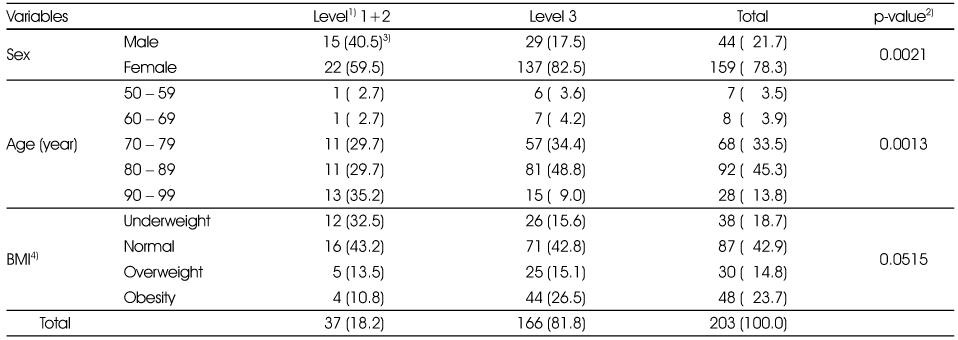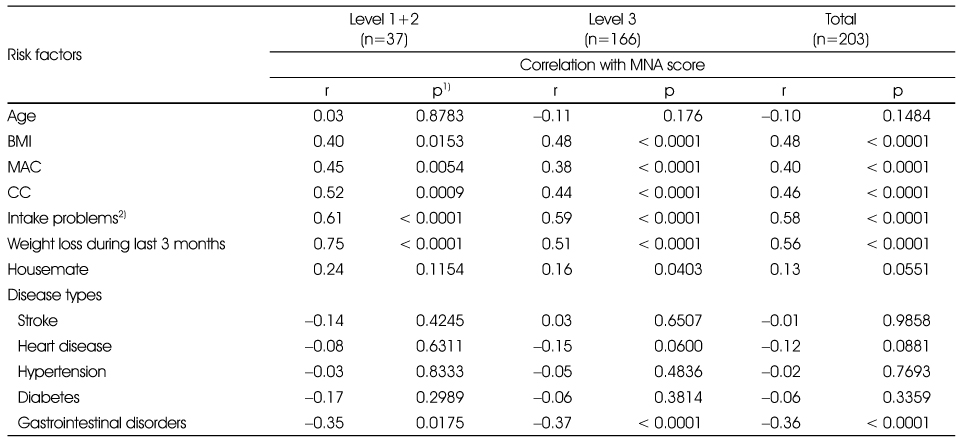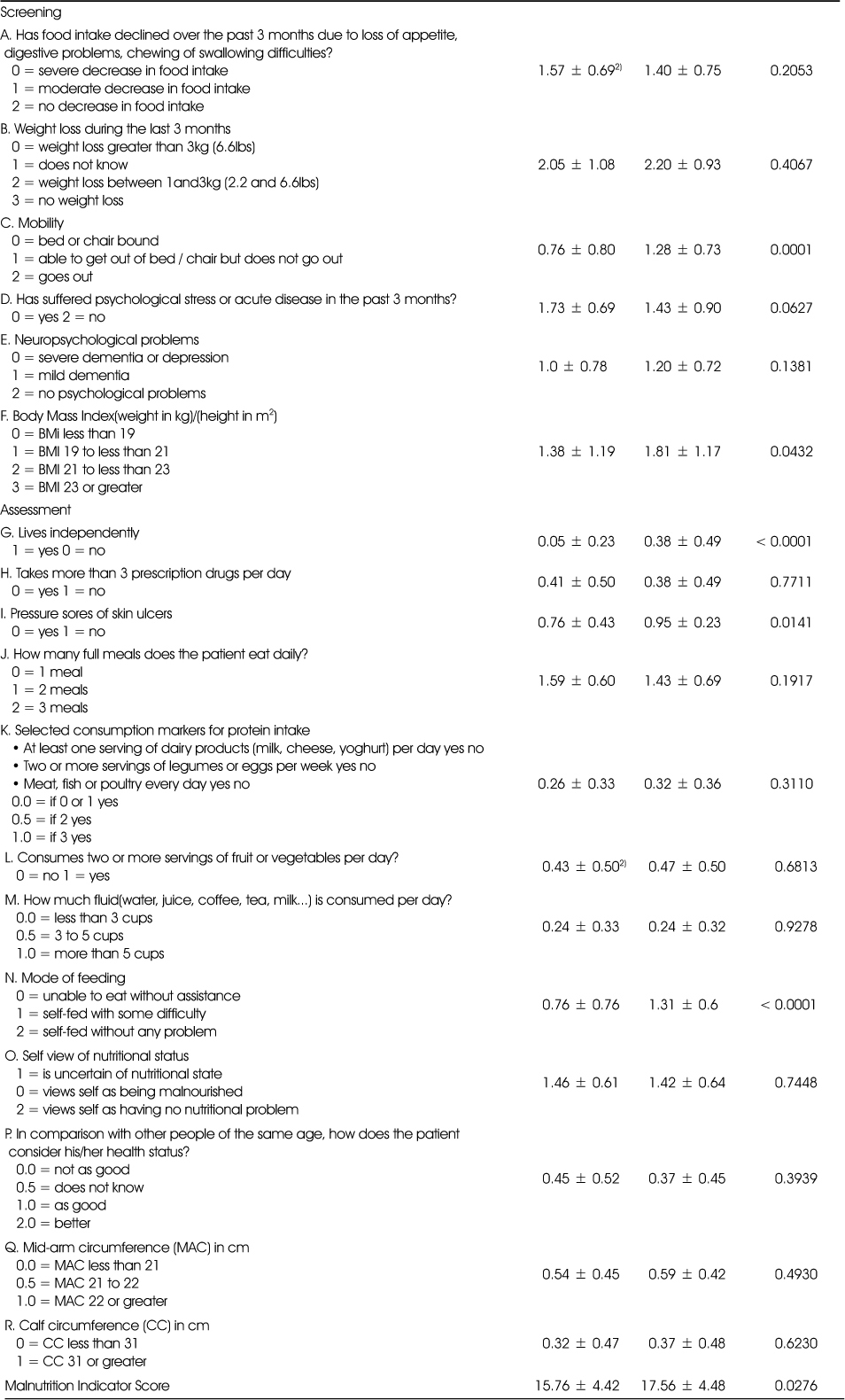Articles
- Page Path
- HOME > Korean J Community Nutr > Volume 18(2); 2013 > Article
-
Original Article
- Nutritional Assessment and Management in Long-term Care Insurance's Home Visit Care Service
- Mi-Ock Yoon, Hyun-Kyung Moon, Seo-Yeon Kim, Bok-Hee Kim
-
Korean Journal of Community Nutrition 2013;18(2):142-153.
DOI: https://doi.org/10.5720/kjcn.2013.18.2.142
Published online: April 30, 2013
Department of Food and Nutrition, Dankook University, Gyeonggi, Korea.
1Department of Food and Nutrition, Chosun University, Kwangju, Korea.
- Corresponding author: Hyun-Kyung Moon, Department of Food and Nutrition, Dankook University, 152 Jukjeon-ro, Suji-gu, Yongin-si, Gyeonggi-do 448-701, Korea. Tel: (031) 8005-3173, Fax: (031) 8021-7200, moonhk52@dankook.ac.kr
Copyright © 2013 The Korean Society of Community Nutrition
- 968 Views
- 2 Download
- 8 Crossref
Abstract
- The purpose of the study was to examine nutritional management and nutritional care demands of home-visit care service and the nutritional status of serviced elderly. The survey was carried out from 5th to 21st of January, 2011 among 37 In-Home Service institutions. The number of elderly surveyed by 143 care helpers was 281. Analysis was performed for 203 subjects (male: 44, female: 159). The age distribution was from 50 to 99 years. The grading by long-term care insuranceshowed 18,2% on level 1 and 2, and 81.8% on level 3. For the disease treatment, the proportion of implementing diet treatment turned out to be very low. The proportion of subjects living with their children was 45.3%, and living alone was 29.1%. The proportion of home-visit care among types of In-Home Service was 70%. Subjects who needed additional necessary diet management service turned out to be 40.9%. Diet management was the most necessary services from all levels. MNA (specifiy MNA) scores were significantly (p < 0.001) associated with BMI, mid-arm circumference (MAC), calf circumference (CC), intake problems, and weight loss during the last 3 months. For studied elderly, 45.3% were malnourished, and 46.8% were at the risk of malnutrition by MNA score. Based on the result of this survey, the nutritional care was not systematic on the In-Home Service. Prevention and management of the disease was much better than the treatment to improve the quality of life. We conclude that nutrition management is necessary for the elderly. To improve nutritional status of elderly in home care services, systematic nutrition management should be implemented.
- 1. Byun YW. An study on the use of long-term home care service in agricultural districts. Korean Soc Secur Stud. 2010; 26(3): 283-308.
- 2. Choe EH. A study on strategic proposal for improving of service quality management system of long-term care (LTC). J Korean Gerontol Soc. 2010; 30(2): 401-419.
- 3. Choi ID, Lee SL, Lee JM. Projection of long-term care insurance: Beneficiary and, personnel and facility. Korean Soc Secur Stud. 2010; 26(2): 375-400.
- 4. Chung SH, Sohn CM. Nutritional status of hospitalized geriatric patients using by the mini nutritional assessment. Korean J Community Nutr. 2005; 10(5): 645-653.
- 5. Guigoz Y. The Mini Nutritional Assessment (MNA) review of the literature. J Nutr Health Aging. 2006; 10(6): 466-485.PubMed
- 6. Kim CH. A comparative study on Long-term Care Insurance System for the Elderly In Germany, Japan and Korea. 2009; Dankook University; 19-43 Dissertation.
- 7. Korea National Statistical Office. The statistics of estimated future population. 2010; cited 2011 February 15. Available from http://www.index.go.kr.
- 8. Korean society for the study of obesity. Koreans obesity treatment guidelines. 2009; cited 2012 November 30. Available from http://www.kosso.or.kr.
- 9. Kuzuya M, Kanda S, Koike T, Suzuki Y, Satake S, Iguchi A. Evaluation of mini-nutritional assessment for Japanese frail elderly. Nutrition. 2005; 21(4): 498-503.ArticlePubMed
- 10. Kwon MY, Lim JY, Lee YW, Kim HS. A study of nurses' perception of the visiting nursing services of long-term care insurance. J Korean Acad Public Health Nurs. 2010; 24(1): 5-18.
- 11. Kim SH, Park CY, Nam CM. Related factor of in-home service utilization in Korean long-term care insurance among certificated elderly living alone. Health Soc Sci. 2011; 29: 237-258.
- 12. Kwon JH, Han EJ, Kang IO. A analysis of relationships among quality, satisfaction and purchase intention perceived by home help service users. J Korean Gerontol Soc. 2010; 30(2): 355-368.
- 13. Kwon SH, Park JR, Lee YK. A study on the elder care facility workers' attitude towards senior citizens and on the perception towards long-term care insurance system for senior citizens. J Korean Soc Dent Hyg. 2010; 10(5): 905-915.
- 14. Lee HO, Lee JS, Shin JW, Lee GJ. Nutrition assessment of older subjects in a health care center by MNA (Mini Nutritional Assessment). J Korean Diet Assoc. 2010; 16(2): 122-132.
- 15. Lee MJ. The status and problem educating care giver in Korea. J Soc Occup Ther Aged Dement. 2008; 2(1): 69-74.
- 16. Lee MJ. A study on measurement issue of the quality of long-term care services for older adults. Soc Welf Policy. 2011; 38(1): 141-165.
- 17. Lim JG. A study on factors of elderly home and community care service utilization. 2009; Baekseok University; 193-234.
- 18. Long Term Care Insurance. Insurance benefit in-home services. 2010; cited 2010 August 22. Available from http://www.longtermcare.or.kr/.
- 19. Nam YJ. A study on the improvement of long-term care insurance for senior citizen in Korea. 2009; Kwandong University; 1-19 Dissertation.
- 20. National Health Insurance Corporation. The statistics of Long Term Care Insurance Service. 2010; cited 2011 February 15. Available from http://www.nhic.or.kr/.
- 21. Nestle Nutrition Institute. MNA® Mini Nutritional Assessment. 2010; cited 2011 December 12. Available from http://www.mna-elderly.com/.
- 22. Pack CJ. Cost-effectiveness analysis of long term care services : Care in institutions vs in-home. J Welf Aged. 2010; 50: 145-172.
- 23. Park JH. Influence of service quality on service satisfaction in the long-term care service at home: Centered on home help service. Soc Welf Policy. 2011; 38(1): 227-246.
- 24. Park JI, Joo JH. Policy suggestions for the development of Korea's national longtermcare insurance program: With special emphasis on the careworker-educating institutions. J Soc Sci. 2009; 29: 17-35.
- 25. Seoh YH, Kim MW. A study on the improvement of visiting care with the introduction of the elderly long term care insurance system. Korean J 21Century Soc Welf. 2010; 7(2): 213-239.
- 26. Sunwoo D. An improvement plan for the government policy on long-term care insurance. Health Welf Policy Forum. 2010; 16-24.
- 27. Vellas B, Guigoz Y, Garry PJ, Nourhashemi F, Bennahum D, Lauque S, Albarede JL. The mini nutritional assessment (MNA) and its use in grading the nutritional state of elderly patients. Nutrition. 1999; 15(2): 116-122.ArticlePubMed
REFERENCES

1) Level: Level 1 = Requires help in all aspects of daily life (score > 95, n = 9); Level 2 = Requires help in most parts of daily life (75 ≤ score < 95, n = 28); Level 3 = Requires help in part of daily life (55 ≤ score > 75, n = 166)
2) By chi-square tests
3) N (%)
4) BMI: Body Mass Index = body weight(kg)/height (m)2 (Underweight: BMI < 18.5, Normal: 18.5 ≤ BMI < 23.0, Overweight: 23.0 ≤ BMI < 25.0, Obesity: BMI ≥ 25.0)

1) Number of disease holder within number of elderly
2) Number of diet therapy within number of disease holder
3) p-values were derived by chi-square tests between prevalence of level 1+2 group and level 3group. but Both were not significant.
4) N (%)
5) Number of disease holder (people with more than one disease counted as one person) with diet therapy

1) by Pearson's correlation test: Age, BMI, MAC, CC, Intake problems, Weight loss during last 3 months; by Spearman's correlation test: Housemate, Disease types
2) Loss of appetite, digestive problems, chewing of swallowing difficulties
MNA: Mini Nutritional Assessment
BMI: Body Mass Index = body weight(kg)/height (m)2
MAC: Mid-arm circumference
CC: Calf-circumference
Figure & Data
REFERENCES
Citations

- Factors associated with malnutrition in demented and non-demented elderly residing in the community of Korea: a cross-sectional descriptive and analytical study
Jinhee Kwon, Jung Hee Kim, Hyeonjin Jeong, Jung Suk Lee
Korean Journal of Community Nutrition.2024; 29(5): 359. CrossRef - The Factors Affecting Frailty among the Elderly in Korea: A Study Using the Frailty Cohort
DaSol Park, Hee-Sun Kim
International Journal of Environmental Research and Public Health.2022; 20(1): 670. CrossRef - Current Status of Sanitary and Nutritional Food Service in Elderly Day Care Center
Jeonghyeon Woo, Yoo Kyoung Park, Mi-Hyun Kim, Soo-Kyung Lee, Kyunghee Song, Hye-Kyeong Kim
Korean Journal of Community Nutrition.2020; 25(5): 374. CrossRef - Feasibility Study on the Dietary Improvement Program Development for Senior Citizens
Sung-Hee Kim, Boram Kim, Nami Joo
Korean Journal of Community Nutrition.2017; 22(3): 218. CrossRef - Job importance, job performance, and job satisfaction in dietitians at geriatric hospitals or elderly healthcare facilities in Jeju
Hye-Sook Kang, Yunkyoung Lee, In-Sook Chae
Journal of Nutrition and Health.2016; 49(3): 189. CrossRef - Comparison of Health Status and Mini Nutritional Assessment according to Self-esteem of Elderly in Care Hospital
Eun-mi Kim, Jin Kwon
Journal of the East Asian Society of Dietary Life.2015; 25(4): 631. CrossRef - Relationship between Sense of Belonging, Powerlessness and Nutritional status of Elderly People
Mi-Hye Kim, Hae-Kyung Chung
Journal of The Korean Society of Food Culture.2015; 30(1): 118. CrossRef - Nutrition Status of Elderly Female Patients in Long-term Care Hospital according to Meal Types and Eating Ability
Hyejin Ahn, Juhee Kang, Hongmie Lee
Korean Journal of Community Nutrition.2014; 19(2): 187. CrossRef
General characteristics of the subjects
1) Level: Level 1 = Requires help in all aspects of daily life (score > 95, n = 9); Level 2 = Requires help in most parts of daily life (75 ≤ score < 95, n = 28); Level 3 = Requires help in part of daily life (55 ≤ score > 75, n = 166)
2) By chi-square tests
3) N (%)
4) BMI: Body Mass Index = body weight(kg)/height (m)2 (Underweight: BMI < 18.5, Normal: 18.5 ≤ BMI < 23.0, Overweight: 23.0 ≤ BMI < 25.0, Obesity: BMI ≥ 25.0)
Disease types and number of elderly with the diet therapy of the subjects
1) Number of disease holder within number of elderly
2) Number of diet therapy within number of disease holder
3) p-values were derived by chi-square tests between prevalence of level 1+2 group and level 3group. but Both were not significant.
4) N (%)
5) Number of disease holder (people with more than one disease counted as one person) with diet therapy
Age and anthropometry of the subjects by the long-term care level
1) p-values were calculated using the t-test comparing between the level 1+2 group and level 3 group
2) Mean ± SD
Diet related variables of the subjects by the long-term care level
1) By chi-square tests
2) N (%)
Comparison of MNA score of the subjects by the long-term care level
1) By t-test
2) Mean ± SD
MNA assesment of the subjects by the long-term care level
1) By chi-square test
2) N (%)
MNA: Mini Nutritional Assessment
Correlations between MNA score and Individual risk factors for malnutrition of the subjects by the long-term care level
1) by Pearson's correlation test: Age, BMI, MAC, CC, Intake problems, Weight loss during last 3 months; by Spearman's correlation test: Housemate, Disease types
2) Loss of appetite, digestive problems, chewing of swallowing difficulties
MNA: Mini Nutritional Assessment
BMI: Body Mass Index = body weight(kg)/height (m)2
MAC: Mid-arm circumference
CC: Calf-circumference
1) Level: Level 1 = Requires help in all aspects of daily life (score > 95, n = 9); Level 2 = Requires help in most parts of daily life (75 ≤ score < 95, n = 28); Level 3 = Requires help in part of daily life (55 ≤ score > 75, n = 166) 2) By chi-square tests 3) N (%) 4) BMI: Body Mass Index = body weight(kg)/height (m)2 (Underweight: BMI < 18.5, Normal: 18.5 ≤ BMI < 23.0, Overweight: 23.0 ≤ BMI < 25.0, Obesity: BMI ≥ 25.0)
1) Number of disease holder within number of elderly 2) Number of diet therapy within number of disease holder 3) p-values were derived by chi-square tests between prevalence of level 1+2 group and level 3group. but Both were not significant. 4) N (%) 5) Number of disease holder (people with more than one disease counted as one person) with diet therapy
1) p-values were calculated using the t-test comparing between the level 1+2 group and level 3 group 2) Mean ± SD
1) By chi-square tests 2) N (%)
1) By t-test 2) Mean ± SD
1) By chi-square test 2) N (%) MNA: Mini Nutritional Assessment
1) by Pearson's correlation test: Age, BMI, MAC, CC, Intake problems, Weight loss during last 3 months; by Spearman's correlation test: Housemate, Disease types 2) Loss of appetite, digestive problems, chewing of swallowing difficulties MNA: Mini Nutritional Assessment BMI: Body Mass Index = body weight(kg)/height (m)2 MAC: Mid-arm circumference CC: Calf-circumference

 KSCN
KSCN




 Cite
Cite


